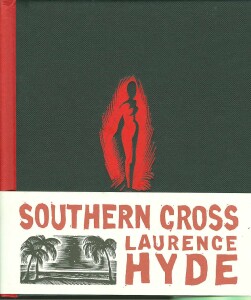 Southern Cross is a novel with no words. Not a graphic novel, as we’ve come to understand them, but a series of 118 wood engravings that when “read” together in sequence tells a story of the atomic bomb tests by the USA in the South Pacific in the days following World War II. There is no text. Once or twice a word appears engraved in the image, but this story is told by images alone. And a powerful story it is.
Southern Cross is a novel with no words. Not a graphic novel, as we’ve come to understand them, but a series of 118 wood engravings that when “read” together in sequence tells a story of the atomic bomb tests by the USA in the South Pacific in the days following World War II. There is no text. Once or twice a word appears engraved in the image, but this story is told by images alone. And a powerful story it is.
Laurence Hyde first published his book in 1951, in a small edition supported by Rockwell Kent and Ward Ritchie Press. Montreal’s Drawn & Quarterly Press has done a superb job of reproducing the original book, with the addition of a new introduction by David A. Berona. The pages of text that are present include the original introduction by Rockwell Kent, two essays by Hyde describing the concept and creation of the book and a brief history of the woodblock novel.
The first thiry-six or so images set the scene in the peaceful South Seas. It’s a quiet existence, fishing and picking fruit from lush tropical forests. Then sleep is broken by the sound of an airplane flying overhead. An aircraft carrier appears in the harbour. The U.S. Navy presents an evacuation plan to the inhabitants of the island. With the plan comes more sailors, booze, lust, rape, murder, escape, and a search, evacuation. For all? Then the test. The fish that swam and fed the islanders now float on top of the sea. The birds no longer fly. The family hidden in the forest. . . .
Hyde’s wood engravings are simple and straightforward. He hoped at the beginning that someone else might take his idea and sharpen them up, but his work is urgent and potent. Black and white, stark, and honest. This is a powerful and moving tale, perhaps made even moreso as it is shown in images alone. All in all a gorgeous book.
(Drawn & Quarterly, 2007)
